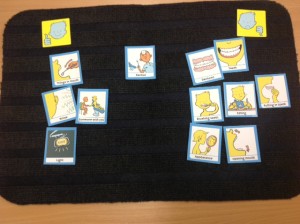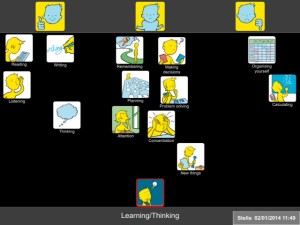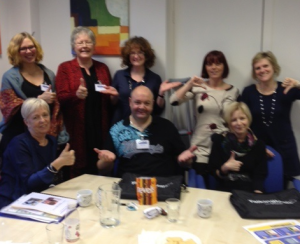The final part of my keynote talk at the AAC Conference in Helsinki last month focused on what we mean by communication effectiveness.
It is important to be able to determine the effectiveness / success of an interaction between two people, whether they are politicians, parent and child, husband and wife….. people using AAC systems or people using their own speech.
When I carried out a literature search of peer reviewed journals for my PhD in 2009 I could find no clear definition of communication effectiveness. Some people thought that effectiveness was synonymous with ‘word intelligibility’ or ‘correct syntax’. Others defined effectiveness in terms of the number of words produced on an AAC device. One publication even suggested that effectiveness was demonstrated by someone taking responsibility for charging their AAC device!
The main focus of all the papers I found, which mentioned communication effectiveness, was on needs and wants and only 3 papers cited social closeness as important (click here to read previous blog).
However, some publications did give useful pointers. Light (1988) emphasised that effective communication depends on 2 way interaction and that the partner is a major factor in the success or failure of communicative interactions. Lund (2006) described adequacy, relevance, promptness and communication sharing as key indicators. Ho et al (2005) highlighted satisfaction – partners’ feeling of how well they communicated during the conversation. Locke (1998) stressed that determining the success of any communication is a subjective undertaking as ‘Communication is not a mathematical formula of phonemes, morphemes and syntax, but rather includes casual conversation such as gossip’.
The Talking Mats team has tried to capture what we believe are the essential factors in determining communication effectiveness. We have produced a simple tool – the Effectiveness Framework of Functional Communication (EFFC) which can be used to chart key factors in an interaction on a 5 point scale and give an overall indication of whether the conversation is effective or not.
We have used the EFFC in several of our research projects and show participants how to use it during our training workshops. In Finland I tried it out with the audience of 200 AAC professionals using 3 video examples of different AAC conversations. The resulting scores were amazingly in agreement suggesting that this is a reliable tool.
For a free download please click here EFFC 2014
We would welcome any comments or questions.
In my last blog I wrote about the purposes of human communication and suggested that social closeness is essential for effective communication. Janice Light, in her 1988 model, described social etiquette as the ability to conform to social conventions of politeness and one of the key purposes of communication.
I believe that social etiquette has been overlooked when working with people with communication difficulties. Social etiquette may be seen as ‘the cherry on the cake’ and not really necessary, when getting a basic message across is so difficult for someone with a communication disability. However, the way in which someone greets you when they meet you, how they show interest in what you are saying or how they say goodbye, all effect how you respond to them and can influence your subsequent interactions with them.
Moreover social etiquette can often be done non-verbally – a smile to show you are pleased to see someone, a nod of agreement to show you are following what they say, a handshake or ‘thanks for coming’/’good to talk to you’ when you say goodbye. These are all basic and almost universal communication symbols.
Social etiquette is not just a communication add-on that can be missed out because it’s too much effort. It can be crucial in developing and maintaining relationships.
For those of us who work or live with people with communication difficulties it’s important that we consider the purposes of human communication. As long ago as 1988 Janice Light suggested that there were 4 main purposes and we believe this is still a good model to bear in mind.
(Light, J. (1988) “Interaction involving individuals using augmentative and alternative communication systems: state of the art and future directions”, AAC, 4, 2, 66-82)
She described these purposes as:
1. Expression of needs and want – to regulate the behaviour of another person to get something
2. Information transfer – to convey information from person A to person B
3. Social closeness – to establish and maintain relationships with others
4. Social etiquette – to conform to the social conventions of politeness
We believe that there is a tendency to concentrate too much on 1 and 2 and not enough on 3 and 4. If we dwell on needs and wants, which is very often the focus of communication aids, there is a danger that the person with the communication difficulty will find it hard to establish and/or maintain relationships.
In 1998 John Locke wrote that ‘small talk’ is crucial for the construction and enjoyment of relationships with others and that by revealing thoughts we elicit reactions from others. This is what we regard as social closeness or engagement. ‘Small talk’ or ‘social closeness’ may sound irrelevant but it is one of the most important purposes of human communication.
(Locke, J. L. (1998) “Where did all the gossip go? Casual conversation in the Information Age”, American Speech Language Hearing Association, 40, 3, 26-31)
Talking Mats, which uses attractive and motivating communication symbols, is one way to help people to express their thoughts and achieve ‘social closeness’, whether they are a 4 year old boy with Downs Syndrome or a 95 year old woman with dementia.
Talking Mats is one of the few resources that is versatile enough to be used as a stroke communication resource, for consulting children and young people or to help with communication difficulties and dementia, to name but three.
It allows people to express their thoughts in a visual way which in turn can elicit a response from their communication partner. Moreover, solid research has shown that Talking Mats increases engagement in people with different communication difficulties.
Click here to see our publications
Not many people enjoy going to the dentist but it can be a real problem for people with communication disabilities.
Recently I wrote about using Talking Mats in a care home to find out the views of an elderly lady with communication difficulties and dementia who had lost her dentures. click here. Using the mats, she was able to tell us that she was unwilling to open her mouth but thought that if someone was with her she might manage better.
Following our Talking Mats conversation the Care Home arranged an appointment with the dentist for the following week. Her son went back over what we had talked about just before the visit. She managed fine, opened her mouth and her treatment was carried out successfully.

Dentistry is a huge problem for many people, but the impact of not being able to cooperate can have serious implications for a person’s appearance, comfort, quality of life and health.
In preparing for a visit to the dentist it’s important that the person understands both what is going to happen and why its happening. Talking Mats is a visual tool that can help the person with communication difficulties both with understanding and also expressing their views. In this way the family and carers can find ways to reassure the person and support them to get the appropriate dental treatment.
Please let us know your thoughts on supporting people in similar situations.
“About half of all people with multiple sclerosis have some degree of problem at some time with aspects of thinking – memory, attention span or concentration. …. Many people may not recognise cognitive symptoms as an aspect of their MS and they can arise early in the course of the condition although the greater the disease duration and severity the more likely problems are to occur”. MS Trust
Talking Mats is one tool which can help people recognise any problems they may be having. It also provides a sensitive way for people to discuss these issues and plan ways to manage their situation.
We have developed a range of topics which encompass virtually all aspects of a person’s life
Insert mind map
The Learning and Thinking topic is particularly relevant. The following is an example of a Talking Mat done with Stella who has MS and lives at home with her husband and 3 children.
Top Scale Used: Managing: Need some help: Not managing
Stella began by putting most of the option symbols between the Managing and Need some help columns. However as more symbols were presented, she took time and thought about each symbol more carefully and changed her mind about many of them.
She said that using Talking Mats helped her realise that she was having some problems. On completion of the mat, she showed it to her husband and together they discussed practical ways of ways of managing her difficulties.
There are a further 12 topics in the Health and Well-being resource that can be helpful to people with MS. these are available either on our app or as Talking Mats original.
I undertook the ‘Talking Mats’ on-line course to acquire a new skill and a way to enhance my communication with people with dementia in practice. I have found the learning strategies used are varied and interactive – so there is not a sense of sameness, even though visually there is a consistent layout to the presentation of each module (this expedites navigation). This enhances engagement and my interest so that I am never reticent in logging on to complete the next module! In the beginning, I felt that I could move a lot quicker through the course if the modules were available once each part was completed, instead of having to wait for feedback on each assignment. However, nearing the end of the training course, the benefits of this approach are now clearer. Spaced learning and spaced practice allows for thinking time and internalisation of the module components. In this way, I have come to appreciate the part skills involved in the overall process and how they come together. I now find myself observing the skills involved and the reactions of all communicating as well as the surrounding environment, body language etc. I have also found myself looking back over the past module materials to ensure I am integrating as I go and to remind myself of the rationales for the actions that need to be taken, as well as ensuring that I am more and more familiar with the new terminology that I have been exposed too.
Little did I know when I signed up that the benefits of learning about and how to use ‘Talking Mats’ would stretch wider than what I initially anticipated or wanted! In completing the course, I am now much more aware of my communication practice in general, and the part-skills involved. I can also now see the wide applicability of ‘Talking Mats’ to different populations, age groups and conditions. Communication is everywhere but it needs to be efficient and effective – I am now more confident that my communication practice will improve as a result of this course. For me this is the best outcome possible.
Please click here to find out how to book on the next course
When I went back to the Care Home where I was piloting our new Social Care symbols the staff told me this story about Ann (see previous blog). Apparently she usually is very quiet and never joins in with activities or with other residents. However when we used Talking Mats with the Activitiies symbols, she told me that she really likes singing and had started singing to me. Later that day, one of the care staff had suggested that she sing again and Ann started a song with him. Gradually other residents joined in and they had a lovely sing-song with Ann leading it!
On another day I used the Social Care symbols with Dorothy who tends to go off track and repeat stories over and over. She was quite sure about what she liked and didn’t like about the Care Home and using Talking Mats was a gentle and easy way to bring her back on topic.
The following are thoughts from Jenni, a Psychologist who attended the Talking Mats Accredited training course.
‘Meeting with five colleagues from Sweden, England and various parts of Scotland for the accredited Talking Mats Training this month has been a fascinating experience. I have been accustomed to using Talking Mats with children and young people over the past seven years, and have seen the value of the approach in helping young people give their views for a meeting – particularly if they have communication difficulties and would struggle either through lack of confidence or skill to speak out when others are present.
However, we were not just a group who work with children and young people. Most came from health settings and examples were drawn from elderly patients, some with dementia, others with autism. As we shared our videos and told our stories it was obvious to me how relevant Talking Mats can be in those settings too. Some of the stories shook me. One person told how she was deep in conversation with a lady over her Talking Mat when the tea lady burst in, poured a cup of tea for the resident, asked if she was having a good time playing at puzzles, then left before any answer could be given. Time and again we found ourselves asking what is it about our institutions that puts routines above real communication and above proper respect for an individual.
In preparing a video to bring to the training I undertook a Talking Mat with my father, who is almost 90. It was a new kind of conversation for us both, but we were surprised – the structure allowed us to talk about what was going well and what needed a bit of an adjustment in domestic life and we both learned from the conversation. I think we will do it again!
Indeed, at one stage in the training we were asked to dream big and look at how we might want to take use of Talking Mats into new areas. I identified some good friends – one 91, one 101 and one 104 – where conversation can become rather one-sided. I am interested in the power of Talking Mats to help create a genuine dialogue when these friends are reminiscing, in other words, to help me to be not just a listener but to enter the dialogue. Having a record of the conversation will help us take the discussion further when we return to it.
As ever, the time spent with Talking Mats colleagues was refreshing, stimulating and I can’t wait to go home and try out some new ideas!’
Jenni Barr, Educational Psychologist
Thank you Joan and Sally for the fantastic hospitality and inspiring 2 day accredited train the trainer course at Stirling university.
I cant wait to carry out our first session with all of the fabulous advice and support materials you have given us. Talking mats can reopen doors to communication that others may fear were closed for ever.
I was so lucky to meet a group of lovely people on the course, who also share the same enthusiasm for using Talking Mats. It is absolutely fantastic to be part of something that is world wide and getting bigger, long may you reign and long live Talking Mats.
Anthony Howe, Assessor/Tutor/Internal verifier
Training and Development Team, Adult Social Care
Tyne and Wear
During the final stages of developing Digital Talking Mats, we invited some people with aphasia and their partners to come and try it out for us. I spent some time talking to Matthew, who has severe global aphasia and dyspraxia. Matthew loves having a chat, but relaxed conversation can be a challenge because Matthew finds it difficult to generate language and sometimes his yes/no responses get mixed up. I used the ‘activities’ topic with Matthew to have a chat about the things he likes (and doesn’t like) doing. Matthew found the Digital Talking Mats easy to use and quickly gave me his views about activities. Using the i-pad made the conversation feel very natural, and Matthew was able to convey his sense of humour – when I asked him about Church; Matthew started to sing the Funeral March! We had quite a laugh about this, and it turned out that at the moment, Matthew really only goes to Church when there is a funeral. Matthew was also able to tell me about things that he finds difficult since his stroke, such as reading and doing DIY. During our conversation, I was struck by how equal the conversation felt. Matthew was able to express his views without feeling pressurised to think of words. I was able to ask Matthew open questions without worrying that I might not understand his responses. Using Talking Mats on the i-pad was easy and relaxed. I could imagine using it with Matthew to have a chat over coffee or at the pub. Perhaps we should think of some conversational symbol sets?
 Online training login
Online training login 








